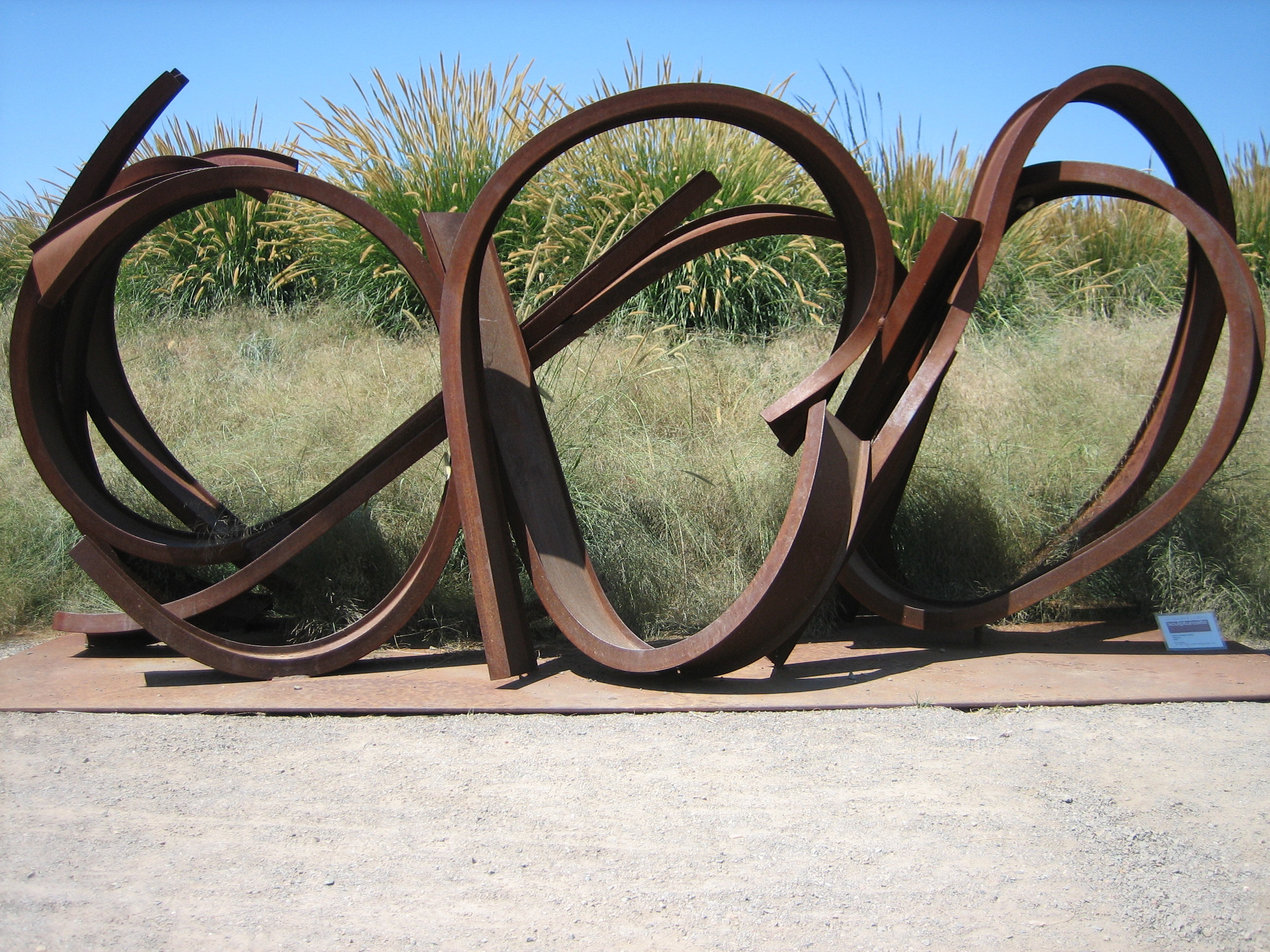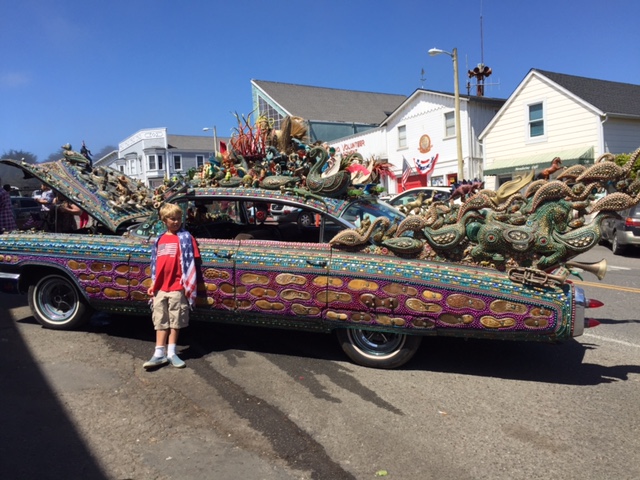Tractor Levitation: Artist Jeff Myers Celebrates Agricultural History

Tractor Levitation, a colorful outdoor sculpture created by Sacramento artist Jeff Myers, celebrates our agricultural history. Weighing in at 2500 pounds, the tractor will be unveiled at the new residential development McKinley Village, the weekend of April 13-14. Myers believes there would be no cities of great scale, or food on our tables, if it were not for the tractor. The mixed-media sculpture, three years in the making, is one of ten works created by local Sacramento artists for the city’s only permanent outdoor art walk. Myers, an accomplished artist with a national following, discussed this multi-layered creation as he was adding the finishing touches.
LS: Can you explain this art you call Tractor Levitation?
JM: Tractor Levitation is a concept I came up with about three and a half years ago. The main idea was to take an old tractor, in this case a 1950’s Ford tractor, and project aerial imagery of agricultural and city grids onto the body of the tractor. I have been working on a photography series for ten years where I project those images onto human flesh, the nude body. So, I thought how interesting it would be to use those elements of my aerial photos of the fields around Sacramento. The photos were cut digitally and I arranged them in a digital collage with oil paintings to integrate both mediums. Then they were heat imbedded into metal. The metal was fabricated in Los Angeles. Then it came back to me to be placed onto the form of the tractor as the new flesh of a very old farming machine that’s been retired.
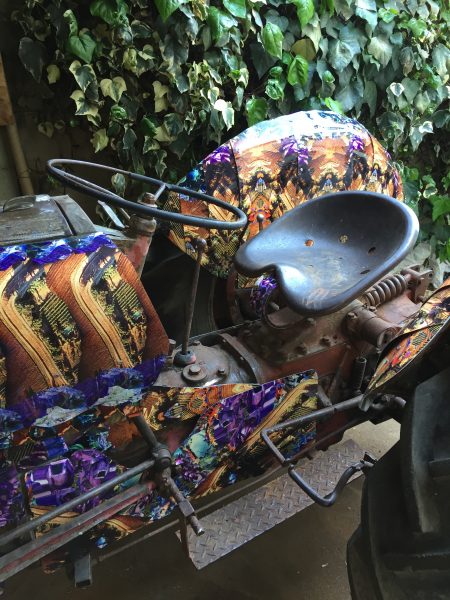
A 1950’s Ford tractor has been masterfully transformed by Jeff Myers.
LS: Where did the tractor come from?
JM: I found this in a tractor graveyard outside of Courtland in the Sacramento Delta. I purchased it from the Fong family, who are fifth generation pear farmers.
LS: Are the photos of the pear orchard?
JM: No, these are random images of vineyards and rice farms taken all up and down the valley. I started doing a repeat thing with the images, kind of like Italian Futurism. All of the miniaturized forms you see are also field patterns projected onto human arms, torsos, or backs.
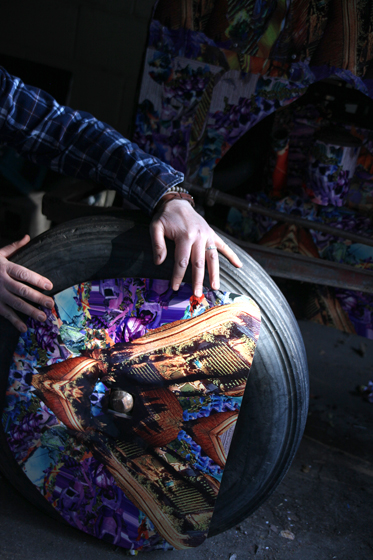
Jeff Myers applying digital photo collage on fabricated metal to Tractor Levitation, April 2018.
LS: While it is a literal tractor, do you consider this an abstract piece of art?
JM: I think if you squint it’s abstract. Then if you look from a distance it reads very abstract. And that’s how it was meant to be. As you get closer, a different type of reading takes place. You can explore the details and it is less abstract. It delineates in a way when you get closer. Your eye is taking in the reference points: that’s a field, or that’s a row of trees, or that’s a figure.
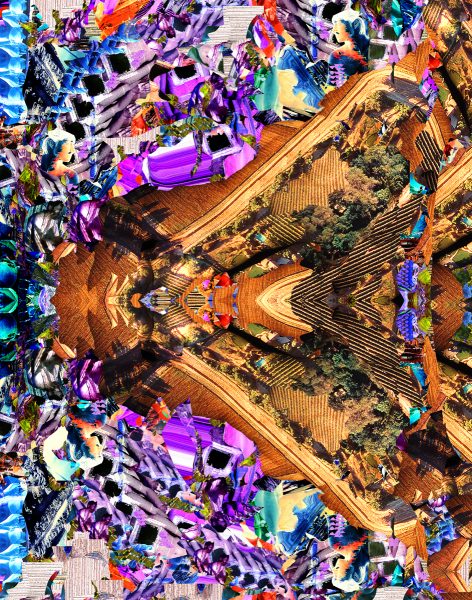
Detail, final version of main wheel, Tractor Levitation, digital photographs/collage, metal, April 2018, Jeff Myers.
LS: In the past you have been known to explore artificial intelligence and the genetic lineage of machines. How does that relate to Tractor Levitation?
JM: To me it’s an undercurrent. I’ve always thought that tractors, and the land levelers, and these old agricultural fragments, were kind of the grandfathers and grandmothers of artificial intelligence. They just kind of feel like they are living things, even though they’re not. There is a convergence of the organic and the boundaries of consciousness. And, I’ve painted the tractor form for so long that each one takes on its own personality like a family. It seemed to fit this project.
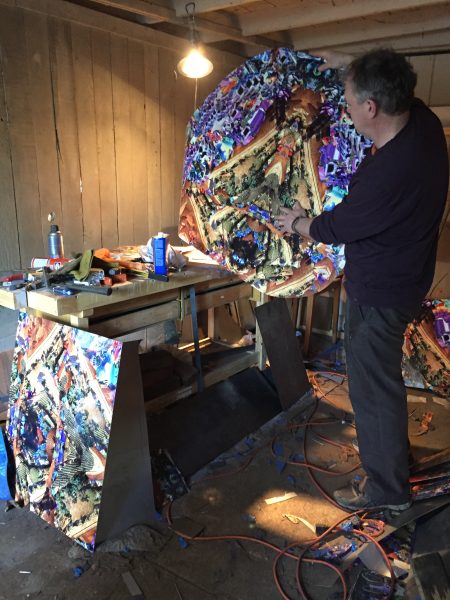
Artist Jeff Myers works with digital photo collage on fabricated metal, April 2018.
LS: Was there a conscious effort on your part to work with recycled materials?
JM: Yes. The tractor itself is the most amazing gigantic recycled material you can run into. To me it’s a cherished material. It’s an image, that in the 21stcentury, we still recognize so easily.
LS: The front of the tractor has a different color scheme and different images. Is there a reason?
JM: No, I just started working on one side, then worked outward piece by piece. If something didn’t look right, I’d come back in and replace it. I approached it just like a painting or collage. I didn’t go in with a stiff, highly articulate design ahead of time. I wanted it to breath as I was going along. Many of the best ideas in here came in the process while working on the tractor itself. It was the first time I’d ever done anything quite like this and I knew I wanted there to be room within the idea to experiment.
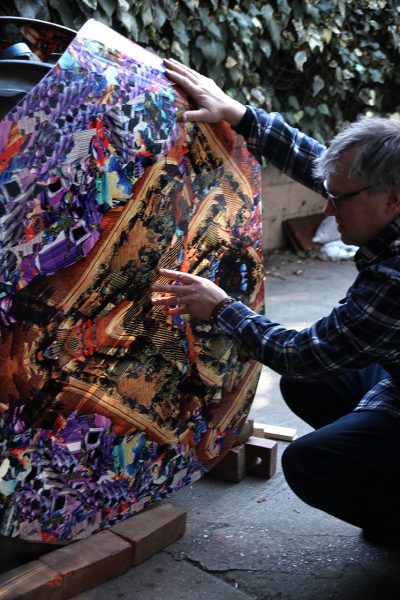
Tractor Levitation, big wheel, digital photos/collage on metal, Jeff Myers, April 2018.
LS: Is this the first tractor sculpture of many more to come?
JM: Maybe. But I was thinking I should do a tank next, an old army tank. I would coat it in a beautiful new type of imagery. It’s a pretty intoxicating idea.
LS: What type of reaction are you seeking from the community?
JM: I hope they feel a celebration of the environment and how close we live to the land, and how we relate to agriculture, and how our food arrives at our table. Hopefully it will be a destination piece which could be intriguing, provocative or fun.
LS: I think you’re onto something. It’s fantastic!
For more information:
http://jeffmyersart.com/home.html
http://www.sacmetroarts.org/Programs/Public-Art/McKinley-Village-Art
